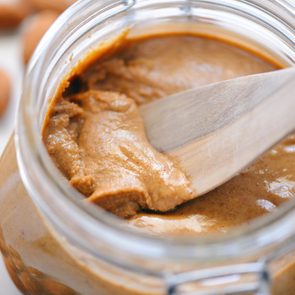How to Make Almond Milk at Home
Updated: Nov. 24, 2020
Almond milk is a nutrient-packed dairy-free milk substitute. Here's how to make almond milk at home without the store-bought added sugar.
Our editors and experts handpick every product we feature. We may earn a commission from your purchases.
How is almond milk made?
As growing numbers of people embrace a plant-based diet, almond milk is emerging as a popular and healthful substitute for dairy milk.
Made from ground almonds and water, almond milk is more than simply good for you. This dairy-free drink has s a lower carbon footprint, making it more environmentally friendly than dairy milk. In addition, its nutty taste and creamy texture are satisfying for people who are lactose intolerant or have milk allergies.
For people who are “trying to follow more of a plant-based diet, almonds and almond milk are a better alternative to dairy products,” says Nancy Courduff, a clinical dietitian at Stella Maris, Mercy Health Services/Mercy Medical Center in Baltimore.
But not all store-bought almond milk is created equal. Many have added sugar which can detract from some of the benefits of almond milk, she notes.
One alternative: Learn how to make almond milk at home. Take a look at the nutrients and potential health benefits.
Almond milk calories and nutrition facts
Here’s a sampling of what you’ll find in one cup (262 grams) of shelf-stable unsweetened almond milk.
Calories: 39
Protein: 1 g (2% DV)
Fat: 2.5 g (4% DV)
Sodium: 189 mg (8% DV)
Carbs: 3.4 g (1% DV)
Fiber: 0.5 g (2% DV)
Calcium: 449 mg (37% DV)
Vitamin E: 6.9 mg (110% DV)
Vitamin D: 2.6 µg (13% DV)
Almond milk health benefits
Calories
Unsweetened almond milk is low in calories, making it a good choice if you’re looking to lose weight or avoid gaining weight.
“Eating whole almonds confers more calories to get that same amount of nutrition in a cup of almond milk, which is a definite plus for the almond milk,” says Sareen S. Gropper, PhD, RDN, professor of nutrition at Florida Atlantic University in Boca Raton.
Adding sugar or flavors like vanilla or chocolate ups the calorie count rather dramatically. Read the labels and choose unsweetened almond milk to maximize the health benefits. (Almonds are among the healthiest nuts you can eat.)
Protein
Dairy milk has more protein than almond milk, Gropper says. So “if your diet is low in protein and you are trying to get more protein, it may be more valuable to choose a lactose-free dairy milk or soy milk,” she says. “With age, you naturally start losing muscle mass, strength, and function. If you don’t get enough protein, you are not going to give your muscles what they need to maintain mass, strength, and function.”
Fat
An 8-ounce glass of almond milk contains around 2.5 grams of fat, but the bulk of this fat is heart-healthy monounsaturated fat. Replacing saturated fat in a diet with healthier fats can lower your risk for heart disease. “Monounsaturated fats have a lot of cardio-protective effects and benefits,” says Gropper. (See how eating almonds can lower your risk of heart disease.)
Vitamin E
An antioxidant powerhouse, vitamin E sops up damaging oxygen-free radicals that can contribute to heart disease and other conditions. Almonds are good sources of E, but much of this can be lost in the processing of almond milk. Manufacturers will often fortify their almond milk with vitamin E to get some of the benefits back, Gropper says.
“You are getting at least the recommended dietary allowance of vitamin E with fortified almond milk, maybe more depending on the brand,” she says. “If you compare that to cow’s milk, you don’t get as much vitamin E.”
Why is that a big deal? “If you are low in vitamin E, the fact that you can get all you need in one cup of almond milk is really positive.”
Calcium
Many almond milks are fortified with calcium, which is essential for healthy bones. And Vitamin D is needed to help your body use calcium. Look for brands that are fortified with extra calcium and vitamin D so you don’t lose out on these benefits, Gropper suggests. (Also, check out these foods with calcium.)
Fiber
When compared to the fiber content in whole almonds, almond milk falls short because it is made with skinless almonds and much of the fiber is found in the shell, explains Lauri Y. Wright, RDN, associate professor of nutrition and dietetics at University of North Florida in Tampa. (Here’s how to increase fiber in your diet.)
What’s more, liquids and solids are separated during the process, which further reduces fiber content, says Wright, who is also a spokesperson for the Academy of Nutrition and Dietetics.
There are many ways to incorporate almond milk into your diet. “Add it to coffee instead of dairy milk, and any recipe you would make with milk can be made with almond milk,” says Courduff.
The best way to get all of the above (and save money, too)? Learn how to make almond milk at home. It’s easy to do!
Homemade Almond Milk Recipe
This homemade almond milk recipe is from Erika Laurion, a Hudson, New York-based dietitian and private chef.
Ingredients:
1 cup raw almonds
3 cups filtered fresh water
Vanilla
Maple syrup
Instructions:
Soak almonds overnight in water. Rinse. Add filtered fresh water. Put mixture in a high-speed blender until very smooth.
Use a special reusable nut milk bag and press from the bottom into a large bowl or pitcher. Add vanilla and maple syrup to taste. Refrigerate and use within a week.























